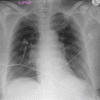Unusual Presentation of Atrial Myxoma: A Case Report and Review of the Literature
- PMID: 33939684
- PMCID: PMC8105743
- DOI: 10.12659/AJCR.931437
Unusual Presentation of Atrial Myxoma: A Case Report and Review of the Literature
Abstract
BACKGROUND Although rare, atrial myxoma is the most common benign cardiac tumor. The recognized triad of presenting symptoms relates to constitutional, embolic, and obstructive effects produced by the tumor. However, the presentation may be non-specific and mimic other diseases, confounding diagnosis. CASE REPORT A middle-aged woman presented with wheezing and shortness of breath. With a strong background smoking history, the initial impression was that of acute bronchospasm. She however deteriorated rapidly, with decreased consciousness and cardiac arrest requiring resuscitation. Despite intensive care management, she died within 1 day of admission. Autopsy revealed a previously undiagnosed left atrial myxoma with coronary and systemic embolization. CONCLUSIONS This case highlights an unusual presentation of atrial myxoma, resulting in fatal simultaneous embolization to the coronary and cerebral arteries. This simultaneous embolic presentation is not common, but the potential consequences are serious. This report also demonstrates that the presentation of a left-sided atrial myxoma with cardiac asthma can mimic respiratory disease and confound diagnosis. In adult patients without a history of chronic respiratory disease, the possibility of cardiac asthma should always be entertained. Furthermore, the importance of considering atrial myxoma as a cause for cardiac asthma is emphasized. The use of transthoracic echocardiogram in aiding the rapid diagnosis of atrial myxoma is recommended. Finally, the continued acknowledgement of the important contribution the academic autopsy makes in complementing and improving clinical practice remains imperative.
Conflict of interest statement
None.
Figures





References
-
- Reynen K. Cardiac myxomas. N Engl J Med. 1995;333(24):1610–17. - PubMed
-
- Binning MJ, Sarfati MR, Couldwell WT. Embolic atrial myxoma causing aortic and carotid occlusion. Surg Neurol. 2009;71(2):246–49. - PubMed
-
- Cho WC, Trivedi A. Widespread systemic and peripheral embolization of left atrial myxoma following blunt chest trauma. Conn Med. 2017;81(3):153–56. - PubMed
-
- Goldblum J, Lamps L, McKenney J, Myers J. Rosai and Ackerman’s surgical pathology e-book. 11th ed. Amsterdam: Elsevier; 2017.
Publication types
MeSH terms
LinkOut - more resources
Full Text Sources
Other Literature Sources

